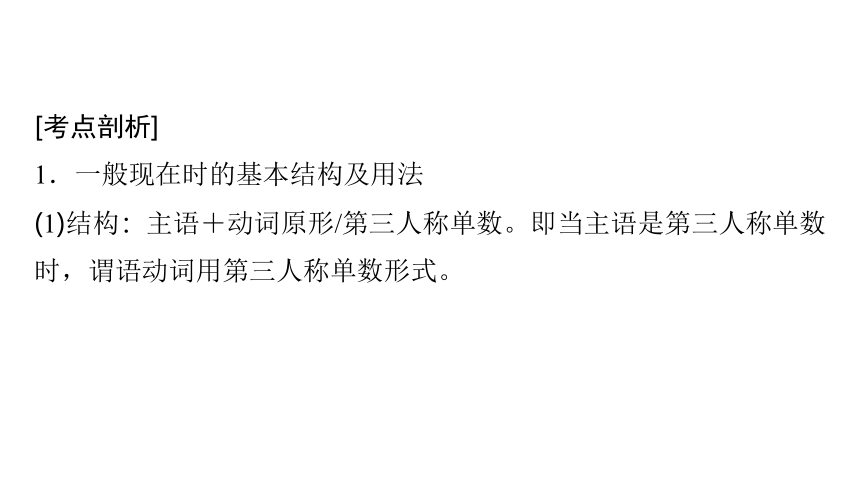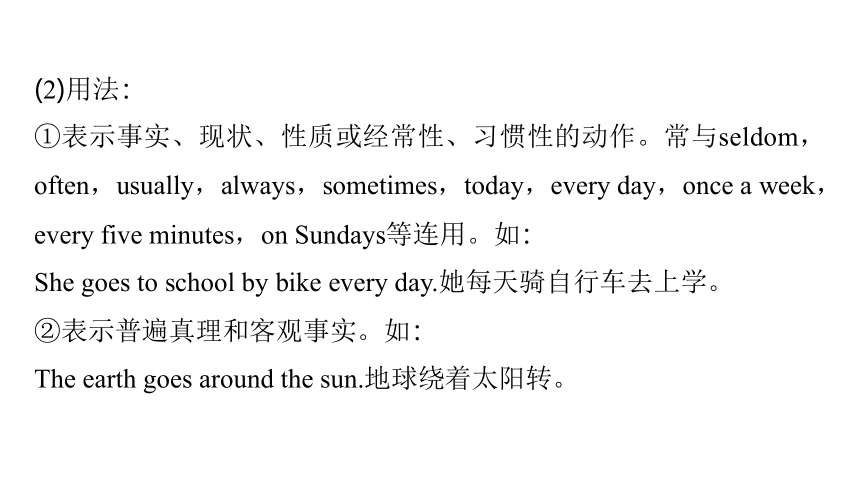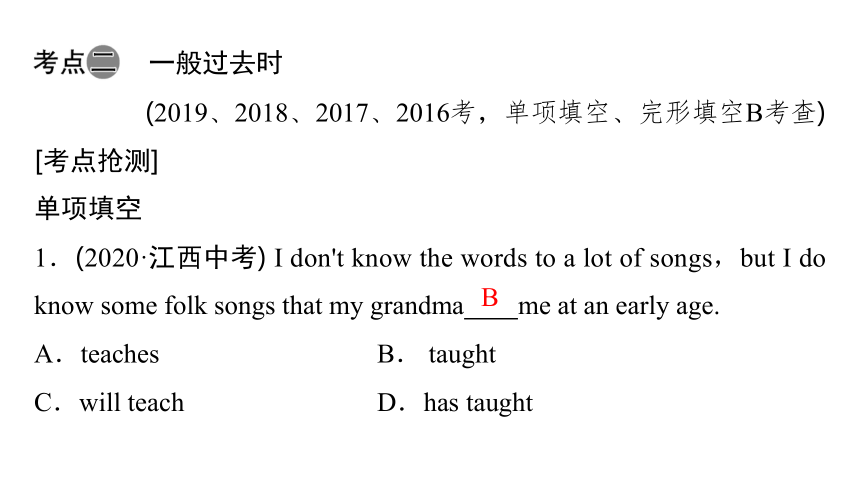2022年中考英语二轮专题复习课件:专题十一 动词的时态(共有PPT63张)
文档属性
| 名称 | 2022年中考英语二轮专题复习课件:专题十一 动词的时态(共有PPT63张) |  | |
| 格式 | zip | ||
| 文件大小 | 1.5MB | ||
| 资源类型 | 教案 | ||
| 版本资源 | 人教新目标(Go for it)版 | ||
| 科目 | 英语 | ||
| 更新时间 | 2022-01-05 08:38:02 | ||
图片预览












文档简介
(共63张PPT)
专题十一 动词的时态
总结与预测:从近五年江西中考来看,动词时态是每年的必考点,单项填空和完形B都涉及这个知识点。
一般现在时
(近五年未考)
[考点抢测]
单项填空
1.(2019·南充中考)—Daddy,when will we go out to fly a kite
—As soon as the rain .
A.is stopping B. stopped
C.will stop D.stops
D
2.(2019·贵阳中考改编)Volunteering the world warmer.Even small things can make a big difference.
A.make B. makes
C.was making D.made
B
3.(2019·武汉中考)She's brought you some eggs.As you know,she __
chickens.
A.keeps B. will keep
C.has kept D.kept
A
[考点剖析]
1.一般现在时的基本结构及用法
(1)结构:主语+动词原形/第三人称单数。即当主语是第三人称单数时,谓语动词用第三人称单数形式。
注意:动词的第三人称单数形式变化规则:
规则 例词
①直接加 s work—works;sleep—sleeps;sell—sells
②以“辅音字母+y”结尾的词,先变y为i,再加 es carry—carries;cry—cries;
try—tries;study—studies
③以s,x,o,ch,sh结尾的词加 es wash—washes;teach—teaches;go—goes;pass—passes;fix—fixes
④特殊 have—has;are—is
(2)用法:
①表示事实、现状、性质或经常性、习惯性的动作。常与seldom,often,usually,always,sometimes,today,every day,once a week,every five minutes,on Sundays等连用。如:
She goes to school by bike every day.她每天骑自行车去上学。
②表示普遍真理和客观事实。如:
The earth goes around the sun.地球绕着太阳转。
③在某些以here,there开头的句子中,可用一般现在时表示正在发生的动作。如:
Here comes the bus.公共汽车来了。
④在含有时间、条件等状语从句的复合句中,主句若用一般将来时,从句用一般现在时代替一般将来时。如:
I'll go shopping with my mother if she is free tomorrow.如果明天我妈妈有空的话,我将和她去购物。
2.一般现在时的疑问句和否定句
一般过去时
(2019、2018、2017、2016考,单项填空、完形填空B考查)
[考点抢测]
单项填空
1.(2020·江西中考) I don't know the words to a lot of songs,but I do know some folk songs that my grandma me at an early age.
A.teaches B. taught
C.will teach D.has taught
B
2.(2020·黑龙江省龙东地区)It has been two months since my father
for Italy.
A.was left
B. left
C.leaves
B
3.(2020·江苏省苏州市)—Wow,you've made so much progress in drawing.
—Thanks.I two online courses this winter holiday.
A.took B. will take
C.take D.was taking
A
[考点剖析]
1.一般过去时的基本结构及用法
(1)结构:主语+动词的过去式
注意:动词过去式的变化规则:
规则 例词
①一般情况下,在动词原形后加 ed watch—watched;work—worked;visit—visited(2017、T31)
②以不发音字母e结尾的加 d live—lived
规则 例词
③以“辅音字母+y”结尾的,变y为i再加 ed study—studied;carry—carried;cry—cried
④以重读闭音节结尾,末尾只有一个辅音字母的,先双写该辅音字母,再加 ed stop—stopped;plan—planned;prefer—preferred
规则 例词
⑤不规则动词的过去式需特殊记忆 take—took;go—went;be—was/were (2016、T58);find—found(2018、T58);say—said(2019、T55)
(2)用法:一般过去时表示过去发生的动作或存在的状态。句中的谓语动词要变为过去式。常与yesterday,last week,two days ago,in 1988等表示过去的时间状语连用。
①表示过去某一时间发生的动作或存在的状态。如:
He went to play basketball with his friends yesterday.他昨天和朋友一起去打篮球了。
②表示过去经常或反复发生的动作。如:
I always wanted to be a teacher when I was young.我小时候一直想当一名老师。
2.一般过去时的疑问句和否定句
一般将来时
(2019、2018、2015考,单项填空、完形填空B考查)
[考点抢测]
单项填空
1.(2020·江西中考)—The coffee's finished!
—Oh,sorry!I to the shop to get some.
A.am going B. was going
C.went D.have gone
A
2.(2020·北京市)If you take this train,you in Shanghai in five hours.
A.arrive B. will arrive
C.arrived D.have arrived
B
3.(2019·重庆中考A卷)Next week,each student in the class a small gift from their teachers.
A.receives B. received
C.will receive D.has received
C
4.Michael in a school in Yunnan from February to June next year.
A.teaches B. taught
C.will teach D.was teaching
C
5.We a birthday party for Mary.It must be a surprise.
A.were having B. had
C.will have D.have had
C
[考点剖析]
1.一般将来时的基本结构及用法
(1)结构:“助动词shall(第一人称)/will(各种人称)+动词原形”或“be going to+动词原形”。
(2)用法:
①表示将要发生的动作或存在的状态,常用的时间状语有 later (on),soon,in a month (in+时间段),next time,from now on,tomorrow等。如:
I shall be eighteen years old next year.明年我就18岁了。
②表示某种必然的趋势。如:
Fish will die without water.没有水,鱼就会死。
(3)“be to +动词原形”或“be about to +动词原形”表示按计划即将发生的动作。如:
They are to visit their friends tomorrow.他们明天打算去看望他们的朋友。
(4)be doing 表示即将发生或安排好要做的事情,常用于这种结构的动词有go,come,leave,start,stay,begin等。如:
When are you leaving for Shenzhen?你将什么时候出发去深圳?
注意:will引导的将来时常表示事情没有经过事先考虑而即将发生;be going to引导的将来时则表示事情经过事先计划、考虑、打算而即将发生。如:
They will arrive here tomorrow morning.明天早晨他们将抵达这里。
I'm going to see a film this afternoon.今天下午我要去看电影。
2.一般将来时的疑问句和否定句
现在进行时
(2019、2016考,单项填空考查)
[考点抢测]
单项填空
1.(2021·江西)—What's the terrible noise
—It's John. He the violin.
A.practiced B. is practicing
C.was practicing D.has practiced
B
2.(2020·重庆市)Listen!Our teacher in the music classroom.
A.sings B. sang
C.will sing D.is singing
D
3.—Lily,where is your father now?Go and get him for lunch.
—Just a moment,please.Father a phone call in his room.
A.makes B. is making
C.made D.was making
B
4.I'm sorry I can't go with you.I the speaking test these days.
A.prepared B. was preparing
C.am preparing D.will prepare
C
5.—Honey,where are you
—I .Just let me put on my shoes.
A.come B. came
C.am coming D.have come
C
[考点剖析]
1.现在进行时的基本结构及用法
(1)结构:am/is/are+动词的现在分词
注意:现在分词的变化规则:
规则 例词
①一般直接在动词后加 ing play—playing
②以不发音字母e结尾的,去e加 ing come—coming;make—making;live—living
规则 例词
③以重读闭音节结尾,末尾只有一个辅音字母的动词,先双写该辅音字母,再加 ing run—running;sit—sitting;begin—beginning
④特殊 lie—lying;tie—tying
(2)用法:
①表示目前正在发生(进行)的动作(不指状态),常用的时间状语有 now,at the moment 等。当有look,listen等表示提示作用的词时,后面的句子常用现在进行时。如:
He is writing a letter to his friend now.他现在正在给他的朋友写信。
Listen! She is singing in the next room.听!她正在隔壁房间唱歌。
②表示现阶段正在进行,而此刻不一定在进行的动作。如:
We are planting trees these days.这些天我们在植树。
③表示位移的动词的进行时表示动作将要发生。此类词有come,go,leave,arrive,fly等,常与表示将来的时间状语连用。如:
They are leaving for England tomorrow afternoon.他们明天下午要去英格兰。
2.现在进行时的疑问句和否定句
过去进行时
(2018考,单项填空考查)
[考点抢测]
单项填空
1.(2020·北京市)I on the computer when Frank called me last night.
A.work B. will work
C.was working D.am working
C
2.(2020·黔西南州)While Mike computer games in his room,his dad came in.
A.is playing B. was playing
C.will play D.plays
B
3.—I went to your office at 9:00 yesterday morning,but you were not in.
—Sorry,I with the manager in the meeting room at that time.
A.am talking B. was talking
C.were talking D.have talked
B
4.(2019·兰州中考)Peter with his classmates for the bus when the earthquake happened.
A.is waiting B. was waiting
C.are waiting D.were waiting
B
5.—Did you hear the strange noise next door at around 10 o'clock last night
—No.I my favorite music in my bedroom.
A.listen to B. listened to
C.was listening to D.am listening to
C
[考点剖析]
1.过去进行时的基本结构及用法
(1)结构:was/were+动词的现在分词
(2)用法:
①过去进行时主要表示过去某一时间点或某一时间段正在进行的动作。常用的时间状语有this morning,the whole morning,all day yesterday,from nine to ten last night,when,while等。如:
John fell down while he was riding his bicycle and hurt himself.约翰骑自行车时摔倒了,弄伤了自己。
What were you doing at ten o'clock last night 你昨晚十点钟在做什么?
They were building a large house last week.上周他们一直在建造一所大房子。(某阶段一直在进行的动作)
②过去进行时常和always等频度副词连用,表示过去经常发生的动作,带有一定的感彩。如:
Jack was always reading books in the library.杰克总在图书馆看书。
2.过去进行时的否定句和疑问句
现在完成时
(2017、2016、2015考,单项填空考查)
[考点抢测]
单项填空
1.(2021·江西)—How do we turn on the oven
—I you, weren't you listening
A.tell B. am telling
C.will tell D.have told
D
2.(2020·黑龙江哈尔滨市)—Hi,Jill.I in my math since you shared your good experience with me.
—Great!Congratulations!
A.have made rapid progress
B.made rapid progress
C.will make rapid progress
A
3.(2020·四川省成都市)Bob,you in this city since 2018.How do you like it
A.lived
B. live
C.have lived
C
4.(2019·福建中考改编)—Look! My mother a new dress for me.
—Wow,it looks very nice on you.
A.is making B. has made
C.will make D.was making
B
5.(2019·淮安中考)—Where are the teachers now
—In the meeting room. They the meeting for 10 minutes.
A.have begun B. have been on
C.have had D.have been held
B
[考点剖析]
1.现在完成时的基本结构及用法
(1)结构:have/has+动词的过去分词
注意:过去分词变化规则基本与过去式变化规则相同。有些特殊变化动词需单独记忆。
(2)用法:
①表示过去发生的动作对现在造成的影响和结果,常与just,already,yet,recently,before,ever,never,twice,three times等连用。如:
I have never been to Shanghai before.I hope to go there one day.我以前从没去过上海。我希望有一天能去那里。
②表示从过去某一时刻开始一直持续到现在的动作或状态,常与“since+时间点”或“since+从句(一般过去时)”,“for+时间
段”及how long,(ever)since,ever,before,so far,in the last/past few years,up to now,till now等时间状语连用。如:
We've planted thousands of trees in the past few years.在过去几年中,我们种了成千上万棵树。
So far there has been no bad news.到现在为止还没有什么坏消息。
2.一般过去时与现在完成时的区别
一般过去时只强调在过去发生过某事或关注的是动作发生的时间、地点、方式等,而现在完成时则强调过去的动作对现在造成的影响。如:
I saw the movie yesterday.昨天我看了这部电影。(强调电影是昨天看的)
I have already seen the film.我已经看过这部电影了。(强调到现在为止看过这部电影了)
3.延续性动词
在现在完成时中,如果有持续的时间状语,则要把非延续性动词变为延续性动词。如:
I have had the book for two days.这本书我已经买了两天了。(用had而不用bought)
I have been in Tokyo for two weeks.我已经来东京两周了。(用been in而不用come to)
注意:常见的短暂性动词变延续性动词:
短暂性动词 延续性动词
arrive at/in sp.
get to/reach sp.
come/go/move to sp. be in sp.
become be
die be dead
leave be away(from)
短暂性动词 延续性动词
close/open be closed/open
begin/start be on
finish/end/complete be over
marry be married
fall asleep/go to sleep be asleep
borrow keep
短暂性动词 延续性动词
buy have
catch/get a cold have a cold
join be a member of/be in
get to know know
put on wear
get up be up
4.have been to,have gone to,have been in的区别
have been to表示“曾经去过某地”,说话时已从该地回来,现在已不在该地;have gone to表示“已去了某地”,说话时已到达某地或在去某地的途中,现在还未回来;have been in表示“已在某地待了多久”,后面跟副词时不用in。如:
—Where is Mrs.Smith 史密斯夫人在哪儿?
—She isn't here.She has gone to England.她不在这儿。她去了英格兰。
专题十一 动词的时态
总结与预测:从近五年江西中考来看,动词时态是每年的必考点,单项填空和完形B都涉及这个知识点。
一般现在时
(近五年未考)
[考点抢测]
单项填空
1.(2019·南充中考)—Daddy,when will we go out to fly a kite
—As soon as the rain .
A.is stopping B. stopped
C.will stop D.stops
D
2.(2019·贵阳中考改编)Volunteering the world warmer.Even small things can make a big difference.
A.make B. makes
C.was making D.made
B
3.(2019·武汉中考)She's brought you some eggs.As you know,she __
chickens.
A.keeps B. will keep
C.has kept D.kept
A
[考点剖析]
1.一般现在时的基本结构及用法
(1)结构:主语+动词原形/第三人称单数。即当主语是第三人称单数时,谓语动词用第三人称单数形式。
注意:动词的第三人称单数形式变化规则:
规则 例词
①直接加 s work—works;sleep—sleeps;sell—sells
②以“辅音字母+y”结尾的词,先变y为i,再加 es carry—carries;cry—cries;
try—tries;study—studies
③以s,x,o,ch,sh结尾的词加 es wash—washes;teach—teaches;go—goes;pass—passes;fix—fixes
④特殊 have—has;are—is
(2)用法:
①表示事实、现状、性质或经常性、习惯性的动作。常与seldom,often,usually,always,sometimes,today,every day,once a week,every five minutes,on Sundays等连用。如:
She goes to school by bike every day.她每天骑自行车去上学。
②表示普遍真理和客观事实。如:
The earth goes around the sun.地球绕着太阳转。
③在某些以here,there开头的句子中,可用一般现在时表示正在发生的动作。如:
Here comes the bus.公共汽车来了。
④在含有时间、条件等状语从句的复合句中,主句若用一般将来时,从句用一般现在时代替一般将来时。如:
I'll go shopping with my mother if she is free tomorrow.如果明天我妈妈有空的话,我将和她去购物。
2.一般现在时的疑问句和否定句
一般过去时
(2019、2018、2017、2016考,单项填空、完形填空B考查)
[考点抢测]
单项填空
1.(2020·江西中考) I don't know the words to a lot of songs,but I do know some folk songs that my grandma me at an early age.
A.teaches B. taught
C.will teach D.has taught
B
2.(2020·黑龙江省龙东地区)It has been two months since my father
for Italy.
A.was left
B. left
C.leaves
B
3.(2020·江苏省苏州市)—Wow,you've made so much progress in drawing.
—Thanks.I two online courses this winter holiday.
A.took B. will take
C.take D.was taking
A
[考点剖析]
1.一般过去时的基本结构及用法
(1)结构:主语+动词的过去式
注意:动词过去式的变化规则:
规则 例词
①一般情况下,在动词原形后加 ed watch—watched;work—worked;visit—visited(2017、T31)
②以不发音字母e结尾的加 d live—lived
规则 例词
③以“辅音字母+y”结尾的,变y为i再加 ed study—studied;carry—carried;cry—cried
④以重读闭音节结尾,末尾只有一个辅音字母的,先双写该辅音字母,再加 ed stop—stopped;plan—planned;prefer—preferred
规则 例词
⑤不规则动词的过去式需特殊记忆 take—took;go—went;be—was/were (2016、T58);find—found(2018、T58);say—said(2019、T55)
(2)用法:一般过去时表示过去发生的动作或存在的状态。句中的谓语动词要变为过去式。常与yesterday,last week,two days ago,in 1988等表示过去的时间状语连用。
①表示过去某一时间发生的动作或存在的状态。如:
He went to play basketball with his friends yesterday.他昨天和朋友一起去打篮球了。
②表示过去经常或反复发生的动作。如:
I always wanted to be a teacher when I was young.我小时候一直想当一名老师。
2.一般过去时的疑问句和否定句
一般将来时
(2019、2018、2015考,单项填空、完形填空B考查)
[考点抢测]
单项填空
1.(2020·江西中考)—The coffee's finished!
—Oh,sorry!I to the shop to get some.
A.am going B. was going
C.went D.have gone
A
2.(2020·北京市)If you take this train,you in Shanghai in five hours.
A.arrive B. will arrive
C.arrived D.have arrived
B
3.(2019·重庆中考A卷)Next week,each student in the class a small gift from their teachers.
A.receives B. received
C.will receive D.has received
C
4.Michael in a school in Yunnan from February to June next year.
A.teaches B. taught
C.will teach D.was teaching
C
5.We a birthday party for Mary.It must be a surprise.
A.were having B. had
C.will have D.have had
C
[考点剖析]
1.一般将来时的基本结构及用法
(1)结构:“助动词shall(第一人称)/will(各种人称)+动词原形”或“be going to+动词原形”。
(2)用法:
①表示将要发生的动作或存在的状态,常用的时间状语有 later (on),soon,in a month (in+时间段),next time,from now on,tomorrow等。如:
I shall be eighteen years old next year.明年我就18岁了。
②表示某种必然的趋势。如:
Fish will die without water.没有水,鱼就会死。
(3)“be to +动词原形”或“be about to +动词原形”表示按计划即将发生的动作。如:
They are to visit their friends tomorrow.他们明天打算去看望他们的朋友。
(4)be doing 表示即将发生或安排好要做的事情,常用于这种结构的动词有go,come,leave,start,stay,begin等。如:
When are you leaving for Shenzhen?你将什么时候出发去深圳?
注意:will引导的将来时常表示事情没有经过事先考虑而即将发生;be going to引导的将来时则表示事情经过事先计划、考虑、打算而即将发生。如:
They will arrive here tomorrow morning.明天早晨他们将抵达这里。
I'm going to see a film this afternoon.今天下午我要去看电影。
2.一般将来时的疑问句和否定句
现在进行时
(2019、2016考,单项填空考查)
[考点抢测]
单项填空
1.(2021·江西)—What's the terrible noise
—It's John. He the violin.
A.practiced B. is practicing
C.was practicing D.has practiced
B
2.(2020·重庆市)Listen!Our teacher in the music classroom.
A.sings B. sang
C.will sing D.is singing
D
3.—Lily,where is your father now?Go and get him for lunch.
—Just a moment,please.Father a phone call in his room.
A.makes B. is making
C.made D.was making
B
4.I'm sorry I can't go with you.I the speaking test these days.
A.prepared B. was preparing
C.am preparing D.will prepare
C
5.—Honey,where are you
—I .Just let me put on my shoes.
A.come B. came
C.am coming D.have come
C
[考点剖析]
1.现在进行时的基本结构及用法
(1)结构:am/is/are+动词的现在分词
注意:现在分词的变化规则:
规则 例词
①一般直接在动词后加 ing play—playing
②以不发音字母e结尾的,去e加 ing come—coming;make—making;live—living
规则 例词
③以重读闭音节结尾,末尾只有一个辅音字母的动词,先双写该辅音字母,再加 ing run—running;sit—sitting;begin—beginning
④特殊 lie—lying;tie—tying
(2)用法:
①表示目前正在发生(进行)的动作(不指状态),常用的时间状语有 now,at the moment 等。当有look,listen等表示提示作用的词时,后面的句子常用现在进行时。如:
He is writing a letter to his friend now.他现在正在给他的朋友写信。
Listen! She is singing in the next room.听!她正在隔壁房间唱歌。
②表示现阶段正在进行,而此刻不一定在进行的动作。如:
We are planting trees these days.这些天我们在植树。
③表示位移的动词的进行时表示动作将要发生。此类词有come,go,leave,arrive,fly等,常与表示将来的时间状语连用。如:
They are leaving for England tomorrow afternoon.他们明天下午要去英格兰。
2.现在进行时的疑问句和否定句
过去进行时
(2018考,单项填空考查)
[考点抢测]
单项填空
1.(2020·北京市)I on the computer when Frank called me last night.
A.work B. will work
C.was working D.am working
C
2.(2020·黔西南州)While Mike computer games in his room,his dad came in.
A.is playing B. was playing
C.will play D.plays
B
3.—I went to your office at 9:00 yesterday morning,but you were not in.
—Sorry,I with the manager in the meeting room at that time.
A.am talking B. was talking
C.were talking D.have talked
B
4.(2019·兰州中考)Peter with his classmates for the bus when the earthquake happened.
A.is waiting B. was waiting
C.are waiting D.were waiting
B
5.—Did you hear the strange noise next door at around 10 o'clock last night
—No.I my favorite music in my bedroom.
A.listen to B. listened to
C.was listening to D.am listening to
C
[考点剖析]
1.过去进行时的基本结构及用法
(1)结构:was/were+动词的现在分词
(2)用法:
①过去进行时主要表示过去某一时间点或某一时间段正在进行的动作。常用的时间状语有this morning,the whole morning,all day yesterday,from nine to ten last night,when,while等。如:
John fell down while he was riding his bicycle and hurt himself.约翰骑自行车时摔倒了,弄伤了自己。
What were you doing at ten o'clock last night 你昨晚十点钟在做什么?
They were building a large house last week.上周他们一直在建造一所大房子。(某阶段一直在进行的动作)
②过去进行时常和always等频度副词连用,表示过去经常发生的动作,带有一定的感彩。如:
Jack was always reading books in the library.杰克总在图书馆看书。
2.过去进行时的否定句和疑问句
现在完成时
(2017、2016、2015考,单项填空考查)
[考点抢测]
单项填空
1.(2021·江西)—How do we turn on the oven
—I you, weren't you listening
A.tell B. am telling
C.will tell D.have told
D
2.(2020·黑龙江哈尔滨市)—Hi,Jill.I in my math since you shared your good experience with me.
—Great!Congratulations!
A.have made rapid progress
B.made rapid progress
C.will make rapid progress
A
3.(2020·四川省成都市)Bob,you in this city since 2018.How do you like it
A.lived
B. live
C.have lived
C
4.(2019·福建中考改编)—Look! My mother a new dress for me.
—Wow,it looks very nice on you.
A.is making B. has made
C.will make D.was making
B
5.(2019·淮安中考)—Where are the teachers now
—In the meeting room. They the meeting for 10 minutes.
A.have begun B. have been on
C.have had D.have been held
B
[考点剖析]
1.现在完成时的基本结构及用法
(1)结构:have/has+动词的过去分词
注意:过去分词变化规则基本与过去式变化规则相同。有些特殊变化动词需单独记忆。
(2)用法:
①表示过去发生的动作对现在造成的影响和结果,常与just,already,yet,recently,before,ever,never,twice,three times等连用。如:
I have never been to Shanghai before.I hope to go there one day.我以前从没去过上海。我希望有一天能去那里。
②表示从过去某一时刻开始一直持续到现在的动作或状态,常与“since+时间点”或“since+从句(一般过去时)”,“for+时间
段”及how long,(ever)since,ever,before,so far,in the last/past few years,up to now,till now等时间状语连用。如:
We've planted thousands of trees in the past few years.在过去几年中,我们种了成千上万棵树。
So far there has been no bad news.到现在为止还没有什么坏消息。
2.一般过去时与现在完成时的区别
一般过去时只强调在过去发生过某事或关注的是动作发生的时间、地点、方式等,而现在完成时则强调过去的动作对现在造成的影响。如:
I saw the movie yesterday.昨天我看了这部电影。(强调电影是昨天看的)
I have already seen the film.我已经看过这部电影了。(强调到现在为止看过这部电影了)
3.延续性动词
在现在完成时中,如果有持续的时间状语,则要把非延续性动词变为延续性动词。如:
I have had the book for two days.这本书我已经买了两天了。(用had而不用bought)
I have been in Tokyo for two weeks.我已经来东京两周了。(用been in而不用come to)
注意:常见的短暂性动词变延续性动词:
短暂性动词 延续性动词
arrive at/in sp.
get to/reach sp.
come/go/move to sp. be in sp.
become be
die be dead
leave be away(from)
短暂性动词 延续性动词
close/open be closed/open
begin/start be on
finish/end/complete be over
marry be married
fall asleep/go to sleep be asleep
borrow keep
短暂性动词 延续性动词
buy have
catch/get a cold have a cold
join be a member of/be in
get to know know
put on wear
get up be up
4.have been to,have gone to,have been in的区别
have been to表示“曾经去过某地”,说话时已从该地回来,现在已不在该地;have gone to表示“已去了某地”,说话时已到达某地或在去某地的途中,现在还未回来;have been in表示“已在某地待了多久”,后面跟副词时不用in。如:
—Where is Mrs.Smith 史密斯夫人在哪儿?
—She isn't here.She has gone to England.她不在这儿。她去了英格兰。
同课章节目录
- 词法
- 名词
- 动词和动词短语
- 动词语态
- 动词时态
- 助动词和情态动词
- 非谓语动词
- 冠词
- 代词
- 数词和量词
- 形容词副词及其比较等级
- 介词和介词短语
- 连词和感叹词
- 构词法
- 相似、相近词比较
- 句法
- 陈述句
- 一般疑问句和否定疑问句
- 特殊疑问句及选择疑问句
- 反意疑问句
- 存在句(There be句型)
- 宾语从句
- 定语从句
- 状语从句
- 主谓一致问题
- 简单句
- 并列句
- 复合句
- 主谓一致
- 主、表语从句
- 名词性从句
- 直接引语和间接引语
- 虚拟语气
- 感叹句
- 强调句
- 倒装句
- 祈使句
- 句子的成分
- 句子的分类
- 题型专区
- 单项选择部分
- 易错题
- 完形填空
- 阅读理解
- 词汇练习
- 听说训练
- 句型转换
- 补全对话
- 短文改错
- 翻译
- 书面表达
- 任务型阅读
- 语法填空
- 其他资料
